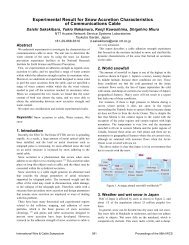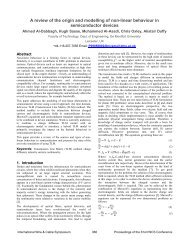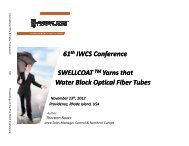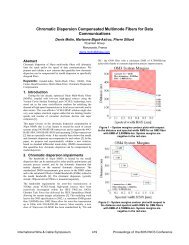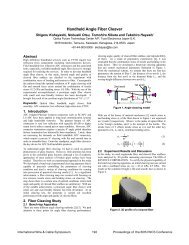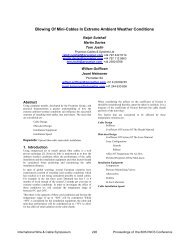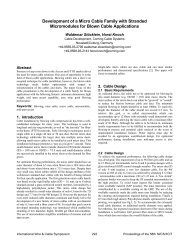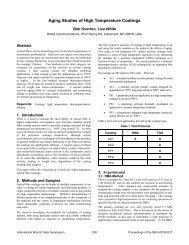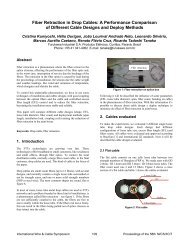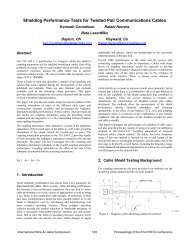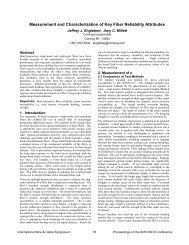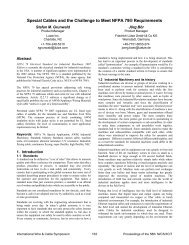Development of Test Method for Rodent Resistance of Optical Fiber ...
Development of Test Method for Rodent Resistance of Optical Fiber ...
Development of Test Method for Rodent Resistance of Optical Fiber ...
You also want an ePaper? Increase the reach of your titles
YUMPU automatically turns print PDFs into web optimized ePapers that Google loves.
<strong>Development</strong> <strong>of</strong> <strong>Test</strong> <strong>Method</strong> <strong>for</strong> <strong>Rodent</strong> <strong>Resistance</strong> <strong>of</strong> <strong>Optical</strong> <strong>Fiber</strong> CableJi LeiBeijing CCS <strong>Optical</strong> <strong>Fiber</strong> CableCo., Ltd.. An Affiliate <strong>of</strong> CorningBeijing, China+86-10-67881199 ext: 8415 ·Lei.Ji@bjcorning.comXu RendongBeijing CCS <strong>Optical</strong> <strong>Fiber</strong> CableCo., Ltd.. An Affiliate <strong>of</strong> CorningBeijing, China+86-10-67881199 ext:8400·Rendong.Xu@bjcorning.comZhang LiBeijing CCS <strong>Optical</strong> <strong>Fiber</strong> CableCo., Ltd.. An Affiliate <strong>of</strong> CorningBeijing, China+86-10-67881199 ext: 8410 ·Li.Zhang@bjcorning.comAbstractDamage to communication cables by rodent gnawing leads tocostly maintenance expenditures and exposes thecommunication link to higher risk <strong>of</strong> service interruption.Several approaches have been used to enhance cable resistanceand extend the service life <strong>of</strong> the cables. The industry wouldbenefit from a statistically repeatable assessment <strong>of</strong> cableresistance to rodents. This paper introduces a testing procedure<strong>for</strong> rodent resistance <strong>of</strong> metallic armored optical fiber cableagainst rodent damage. It is a repeated cycling <strong>of</strong> a rodentgnawing phase and an accelerated corrosion phase. The newmethod focuses on the remaining capability <strong>of</strong> the undamagedsections <strong>of</strong> cable after rodent gnawing. Experimental dataillustrate that the new procedure exhibits good repeatability andreproducibility with an acceptable accuracy. A ‘rodentresistance index’ <strong>of</strong> cables is proposed to reflect the overallresistance <strong>of</strong> cables against rodent induced damages.Keywords: Cable; <strong>Rodent</strong> resistance; <strong>Test</strong> method; Gnaw;Environmental corrosion1. IntroductionThe rodent population is large. In fact, 40 percent <strong>of</strong> all furcovered mammals are rodents. They have a long pair <strong>of</strong>constantly growing upper and lower incisor teeth which arerootless and covered with hard enamel. They brux and grindtheir teeth to a suitable length by gnawing on almosteverything. In the communications industry, rodents are aconcern because they gnaw on cables leading to costlymaintenance expenditures while exposing the communicationlink to a higher risk <strong>of</strong> service interruption.Research <strong>of</strong> cable resistance against rodent damages can betraced back to World War II when Bell Laboratories beganstudying the effects <strong>of</strong> gopher damage to buried cables [1] .Several approaches have been used to enhance cable resistanceand extend the service life <strong>of</strong> the cables. Special installation andplacement treatment approaches are available in the filed. Thispaper focuses on the enhancement <strong>of</strong> the cable itself. Theenhancements can be divided into physical protection andchemical repellents/pesticides. Chemical repellents/pesticidesdo not appear to be practical in the industry <strong>for</strong> several reasons:1. The effectiveness <strong>of</strong> repellents/pesticides is weakened by thebehavior <strong>of</strong> rodents to avoid getting any <strong>of</strong> the treated materialin their mouths while gnawing on the cable. 2.Repellents/pesticides may undergo dissolving into surroundings,oxidation from air, heat and light, and other chemical processesleading to decreasing effectiveness over time. 3. Leaching <strong>of</strong>these materials into the moist soils causes environmentalpollution issues. 4. The requisite properties <strong>of</strong> sheath material,e.g. strength, extrusion per<strong>for</strong>mance etc, may be altered afterblending with repellents/pesticide. 5. Repellents/pesticidesbring health hazard potential to factory employees andinstallation crews.In regards to physical cable protection, Howard believes at leastone species <strong>of</strong> rodent, gopher (Thomomys bottae), may have theability to penetrate all non-metallic and s<strong>of</strong>t metallic kinds <strong>of</strong>armor [1] . Cables with multiple metallic armoring may be apromising solution option and was chosen to be the approachtested in our study.The industry would benefit from a statistically repeatableassessment <strong>of</strong> cable resistance to rodents. Such a test wouldallow cable products from different factories to be compared sothat improvements to the rodent resistance <strong>of</strong> the cable could bemade. Conventional test methods utilize rodent gnawing andsubjective-based rating system with either wild species orlaboratory rats [1, 2 ]. To better understand the mechanism <strong>of</strong>how gnawing initiates damage and to quantify the test results, avariety <strong>of</strong> studies have been conducted. These studies includethe following: using a gnathodynameter to study the biting<strong>for</strong>ce, gnawing frequency and failure modes <strong>of</strong> cables, there<strong>for</strong>eexamining the material susceptibility to rodent damage [3] ;automated mechanical simulation <strong>of</strong> rodent behavior [4] ; andemployment <strong>of</strong> an alloy copy <strong>of</strong> rodent incisors [5] .2. Environmental CorrosionThe severity <strong>of</strong> damages by rodent gnawing is affected bycable design, installation method and geography. The lattertwo factors are closely related to species <strong>of</strong> rodent, theirpopulation density and environmental factors. Among thesefactors, the impact <strong>of</strong> environmental corrosion might havebeen underestimated in cable industry. Connolly and Cogeliapointed out that, although armored cables <strong>of</strong>fer some degree <strong>of</strong>protection, corroded armor is less resistant to gopherpenetration [6] . The corrosion rate <strong>of</strong> carbon steel to fieldconditions in tropical/subtropical environments is up to0.958mm/year in Lagos, Lighthouse Beach, Nigeria. For urbanindustrial environments, it is 0.165 mm/year in Guiyang,China [7] . Exposed carbon steel tapes used in a conventionalcable, generally thinner than 0.2mm, would be per<strong>for</strong>ated bycorrosion within several months or few years at best. Metalliccorrosion is electrochemical in nature, i.e. galvanic corrosion.Factors that affect the corrosion process are: rain, moisturecontent <strong>of</strong> the surrounding environment, pollutant content,mineral composition, grain size distribution, redox potential,electrical conductivity, pH, total acidity, chlorideconcentration, microbiological activity, etc. [7] . Cables in allinstallation environments undergo corrosions, whether in air,soil or water.International Wire & Cable Symposium 330 Proceedings <strong>of</strong> the 59th IWCS/IICIT
A hypothetical demonstration is presented in Figure 1 to showhow environmental corrosion causes deterioration <strong>of</strong> the steeltape which in turn increases the probability <strong>of</strong> one-bite cablepenetration. Assume the distribution <strong>of</strong> biting <strong>for</strong>ce <strong>for</strong> a givenspecies <strong>of</strong> rodent in installation environment and the strengthdeterioration <strong>of</strong> exposed metallic armor corresponding to aconstant environmental corrosion rate, <strong>for</strong> simplicity, arealready known. At a given time1, there is a correspondingmetallic armor strength2 , which has a capability to resist thebites not higher than the biting <strong>for</strong>ce 3 . There<strong>for</strong>e thepossibility <strong>of</strong> one-bite penetration 4 at this time can beacquired by integrating possibilities <strong>of</strong> the upper sectionsalong the biting <strong>for</strong>ce distribution curve. With the sameprocedure, probability <strong>of</strong> one-bite penetration along timecoordinates could be obtained. The one-bite penetrationprobability curve shows the impact <strong>of</strong> environmental corrosionon an armoring layer. The risk <strong>of</strong> interruption increases overtime even though the initial strength might be higher than themaximum biting <strong>for</strong>ce. Furthermore, if an acceptanceprobability level was defined the service life related to thisprobability could be obtained.This probability curve presents the fact that because <strong>of</strong> the impact<strong>of</strong> environmental corrosion, one-bite penetration probability <strong>of</strong> anarmoring layer, thus the risk <strong>of</strong> interruption, increases over time,even though the initial strength might be higher than themaximum biting <strong>for</strong>ce. Moreover, theoretically, if an acceptanceprobability level was defined, the service life related to thisprobability could be obtained.3. <strong>Test</strong> Procedure and Configuration3.1 <strong>Test</strong> ProcedureThe proposed test procedure <strong>for</strong> cables with multiple metallic armors ismeant to reflect the damage process described above. It focuses moreon the remaining capability <strong>of</strong> the undamaged sections <strong>of</strong> cable afterrodent gnawing than the layers that have been damaged. The procedureis a repeated cycling <strong>of</strong> a rodent gnawing phase and a corrosion phase:1) 20 cages mounted with cable samples are exposed to rodent gnawing<strong>for</strong> 10 days.2) Samples with exposed and partly damaged metallic armor bygnawing are put into a corrosive solution. Corrosive per<strong>for</strong>ation timeshould be observed and recorded to quantify the test results. Theper<strong>for</strong>ation time is a complicated quantity, which is dominated byphysical and chemical properties <strong>of</strong> metallic armor materials andaffected by damages from rodent gnawing and damages during themanufacturing process.3) Remove the corroded layers <strong>of</strong> cable samples.4) Repeat steps 1 through 3 until the innermost armor is corroded.3.2 Configuration3.2.1 <strong>Rodent</strong>. Laboratory rats are chosen in place <strong>of</strong> wild rodentspecies <strong>for</strong> better control <strong>of</strong> rodent characteristics. There are more than2000 species <strong>of</strong> rodent distributed around the world, and approximately216 species in China. Using different species <strong>of</strong> rodents would makeresults from multiple tests incomparable. In our study, Sprague Dawleyrats are used since they are considered to be slightly more aggressivethan other laboratory rats. They are 12 ~ 24 weeks old, 250g ~ 300g inweight, healthy with normal incisors, half male and half female. Each <strong>of</strong>them is put into separate cages and all <strong>of</strong> them are replaced with a newbatch every 5 days. No food but sufficient water is supplied <strong>for</strong> the first3 days. Normal food and water supply the last 2 days. Lightingconditions are controlled <strong>for</strong> 12-hour illumination and 12 hoursdarkness. As a general rule, configurations should be adjusted tocon<strong>for</strong>m to applicable laws and regulations when applying thisprocedure in different regions.Figure 1. A demonstration <strong>of</strong> environmental corrosioneffects in metallic armored cableBased on the analysis, the main failure mode <strong>of</strong> optical fiber cablesinitiated by rodent gnawing is a function <strong>of</strong> both gnawing andenvironmental corrosion. For a cable with multiple armoring layers,damage takes place from the outer part to the inner parts <strong>of</strong> the cable.The most damaging scenario would be the following: 1. <strong>Rodent</strong>gnawing destroys the outmost parts with non-metallic or s<strong>of</strong>tmetallic materials quickly. 2. The outermost hard metallic armoringdeteriorates by environmental corrosion and gnawing damagethereby exposing the inner parts <strong>of</strong> the cable with environmentalcorrosion being the dominating factor in this stage. 3. The <strong>for</strong>mertwo stages take place repeatedly until the innermost part <strong>of</strong> cable,i.e. core <strong>of</strong> the cable, is exposed. 4. The final stage is that rodentsgnaws through the tube and destroys the optical fiber.Figure 2 . Schematic <strong>of</strong> cage with cable sampleinstalled3.2.2 <strong>Test</strong> Apparatus. Cages used in gnawing stage are made <strong>of</strong>stainless steel wire grilles with a dimension <strong>of</strong> 350mm x 180mm x250mm. Cable samples are horizontally fitted onto the mountingboard separating the cage into two rooms with a length <strong>of</strong> 250mmand 100mm respectively. Rats are fed in the 250mm-long room.Some food is put into the other 100mm-long room as unreachableattractants. Cable samples are stably fixed with a 5mm~15mmseparation No displacement, slip or rotation is allowed during testperiod. Specific lengths <strong>of</strong> cable are exposed to the rat’s gnawingby a 70mm-wide window in the mounting board. The overlap part<strong>of</strong> outermost wrapped steel tape is placed away from the rats, asillustrated in figure 2.International Wire & Cable Symposium 331 Proceedings <strong>of</strong> the 59th IWCS/IICIT
3.2.3 Corrosive Solution. The corrosive solution used in thecorrosion phase is 0.3mol/L hydrochloric solution (HCl) withsodium chloride (NaCl ) added to the saturation point which leads toan accelerated corrosion process and a shorter test duration.4. Experiments4.1 Experiment 1. The first experiment was conducted in WestChina School <strong>of</strong> Public Health SiChuan University. It was astandard configuration trial (group A) with a replication (group B),40 cages in total. 120 pieces <strong>of</strong> cable samples ( 3 pieces per cage)were taken from a cable shorter than 20m with corrugated,electrolytically chrome coated low carbon steel tape as outer andinner armors. The structures and other cable characteristics can beconsidered constant.Due to the put-up procedure, a solution with saturated sodiumchloride (NaCl) was made first, and it was used to adjust thehydrochloric solution to the pH <strong>of</strong> 0.3mol/L. The chloride ionconcentration <strong>of</strong> the corrosive solution used was slightly lowerthan a<strong>for</strong>ementioned solution, but remained constant in thisexperiment.4.1.1 Gnawing Phase. The percentage <strong>of</strong> samples with exposedsteel tape <strong>for</strong> two groups during the gnawing phase exhibits similarevolution tendency, as illustrated in Figure 3. Chi-square statisticaltesting verified that there are no sufficient reasons to refuse thehypothesis that data <strong>of</strong> two different groups come from the samepopulation <strong>of</strong> a random variable. Since the outer and inner jacketshave different thickness and different diameters, the exposed sampleamounts are significantly different <strong>for</strong> the inner and outer armors.This reflects the variation <strong>of</strong> cable structures. Whether the steel tapearmors have been damaged in different levels has not been readilyinvestigated at this point. Further tests will reveal the differences.Sample amount /pcs6050403020100Group A: Inner armorGroup B: Inner armorGroup A: Outer armorGroup B: Outer armor0 1 2 3 4 5 6 7 8 9 10Time /daysFigure 3.The evolution <strong>of</strong> exposed sample amountAfter the gnawing phase, it can be observed that damage levelvaries from no obvious damage to fully exposed steel tape, asillustrated in Figure 4. The rating variances combined with resultsthat are not quantified determine the inherent instability and poorrepeatability <strong>of</strong> conventional subjective-based rating system.Figure 4. Damage level variation during gnawingSignificant rusting was also observed on several exposed steel tapesbecause <strong>of</strong> rat urine, saliva or other excreta further emphasizing theimpact <strong>of</strong> corrosion.4.1.2 Corrosion Phase. Cable samples with exposed steel tapewere dipped into the corrosive solution in separate containers. Forcomparison, 14 samples <strong>for</strong> outer armor and 15 samples <strong>for</strong> innerarmor, with part <strong>of</strong> the jacket on each sample manually ripped <strong>of</strong>fto expose a ~30mm x 5mm window <strong>of</strong> corresponding steel tapewere corroded with the same procedure as the rodent exposedsamples. Corrosive solution was replaced at the same time everydaywhen inspections were made. The corrosion process was continueduntil all steel tapes corroded to visible per<strong>for</strong>ation (with a hole about1mm 2 in size).Figure 5 presents the results <strong>of</strong> per<strong>for</strong>ation time. Severalconclusions can be directly drawn from it: 1. Per<strong>for</strong>ation times <strong>of</strong>Group A and Group B exhibit similar distributions. 2. <strong>Rodent</strong>gnawing causes damage on the steel tape, leading to significantper<strong>for</strong>ation time reduction when compared to manually ripped-<strong>of</strong>fsamples that had minor initial defects. 3. The severity <strong>of</strong> damagefrom sample to sample is variable since the per<strong>for</strong>ation <strong>of</strong> gnawedsamples shows a widened distribution. 4. The inner tape damageis a bimodal distribution. The causes lie in that the chromecoating <strong>of</strong> steel tapes <strong>of</strong> some samples had been completelydamaged.Percentage /%Percentage /%40 Group AGroup B30 Manual rip-<strong>of</strong>f201004 5 6 7 8 9 10 11 12 13 14 15 1680604020Outer ArmorInner Armor04 5 6 7 8 9 10 11 12 13 14 15 16Per<strong>for</strong>ation Time /daysFigure 5. Corrosive per<strong>for</strong>ation time <strong>of</strong> experiment 1The average per<strong>for</strong>ation times <strong>for</strong> Group A are outer armor: 8.69days; inner armor: 7.17 days. For Group B the times are outerarmor: 8.86 days; inner armor: 7.32 days. For the manually exposedsteel tape reference group the times are outer armor: 14.27 days;inner armor: 12.6 days. There is a small deviation between groups[~2%, Deviation=abs(D 1 -D 2 )/min(D 1 ,D 2 )] and a significantreduction in corrosion time compared to the reference samples. Inaddition, even though the Sprague Dawley rats can not completelypenetrate the armor, they have the ability to damage it.Several statistical tests, including 1-Way ANOVA and N-WayANOVA, were per<strong>for</strong>med on the data and consistent results wereobtained. The analysis illustrates that there is a significant differencebetween two armors, no significant difference between two groupsand no significant effect <strong>of</strong> interaction. Analysis also shows nosignificant difference between male and female rats. The result <strong>of</strong>N-Way ANOVA is included in Table 1 where X1 is a factor whichcomes from differences between outer armor and inner armor, X2 isInternational Wire & Cable Symposium 332 Proceedings <strong>of</strong> the 59th IWCS/IICIT
a factor that comes from differences between two groups, X1*X2 isthe interaction <strong>of</strong> those two factors.Table 1. Results <strong>of</strong> N-Way ANOVASource Sum Sq. d.f. Mean F Prob>FSq.X1 89.401 1 89.401 46.774 1.5004E-10X2 0.966 1 0.966 0.505 0.478X1*X2 0.0047 1 0.0047 0.0024 0.961Error 313.46 164 1.911Total 404.29 167Note that less than 10 rats were typically usually used in previousliteratures. In this experiment, 20 cages were used with rat changesevery 5 days. A convention is that results <strong>of</strong> any zoologicalexperiment may exhibit repeatability and are considered acceptablewhen more than 15 animals are used.A way to determine the number <strong>of</strong> cages is to view the datadifferently. Pick out cages 1; 1~2; 1~3; …; 1~40 in sequence andcalculate the average per<strong>for</strong>ation time to generate 40 virtual testresults <strong>of</strong> different populations <strong>of</strong> cages. To put this into a moregeneral sense, randomly pick out 1 cage, 2cages, …, 40 cages andcalculate the average per<strong>for</strong>ation time. A virtual evolutionsequence varying on populations <strong>of</strong> cages is obtained. The resultsare demonstrated in Figure 6, where the average time <strong>of</strong> all 40cages is treated as the theoretical mean.Absolute deviation <strong>of</strong>average per<strong>for</strong>ation time /%Absolute deviation <strong>of</strong>average per<strong>for</strong>ation time /%25201510252015105Randomly selected (5 sets)Prearranged order00 5 10 15 20 25 30 35 405Cage population /pcsa) Outer armoringRandomly selected (5 sets)Prearranged order00 5 10 15 20 25 30 35 40Cage population /pcsb) Inner armoringFigure 6. The dependence <strong>of</strong> the deviation <strong>of</strong> averageper<strong>for</strong>ation time on the population <strong>of</strong> cagesWhile the population <strong>of</strong> cages increases, the fluctuation at thebeginning tends to become more stable and convergence. A deviationon a level <strong>of</strong> less than 5% is achieved when the population <strong>of</strong> cagesreaches 20. The amount <strong>of</strong> 20 appears to be a reasonable choice togain acceptable repeatability.4.2 Experiment 2. The purpose <strong>of</strong> the second experiment is toverify if consistent results could be reproduced by different people atdifferent locations with same test procedure. Two experimental trialswere conducted separately by different staff in both China School <strong>of</strong>Public Health SiChuan University (located in Chendu, Sichuanprovince, China;) and Capital Medical University (located in Beijing,China). These two locations represent Southern China and NorthernChina respectively. The stainless steel outer armor <strong>of</strong> cable sampleswere tested in this experiment. The amount <strong>of</strong> samples with exposedmetallic armor after gnawing is 16 <strong>for</strong> both two institutes. Theaverage per<strong>for</strong>ation times are 45.31 days and 44.31 days respectively.The deviation is ~2.26%. The distribution <strong>of</strong> per<strong>for</strong>ation time ispresented in Figure 7. The two institutes produced consistent testresults indicating good reproducibility <strong>of</strong> the procedure.Percentage /%40302010SiChuan UniversityCapital Medical University040 41 42 43 44 45 46 47 48 49 50 51Per<strong>for</strong>ation Time /daysFigure 7. Corrosive per<strong>for</strong>ation time <strong>of</strong> experiment 25. <strong>Rodent</strong> <strong>Resistance</strong> Index <strong>of</strong> CableBased on data acquired in the test, a ‘rodent resistance index’ <strong>of</strong>cable, R Cable , is proposed here. R Cable is a weighted sum <strong>of</strong> averageper<strong>for</strong>ation time <strong>of</strong> test cycles and meant to reflect the overallper<strong>for</strong>mance <strong>of</strong> the cable resistance against rodent initiated damages.N( i )R = ∑ lao T + c(1)Cable i i i ii=1Where, T i is the average per<strong>for</strong>ation time <strong>for</strong> the ith metallic armor.i indicates the layers <strong>of</strong> metallic armors, from outmost to innermost,or the sequence number <strong>of</strong> corrosion phase if some s<strong>of</strong>t metallicarmor was directly penetrated by rodent gnawing. N is the totalamount <strong>of</strong> metallic armors or corrosion phases. l i is the weightcorresponding to the layers <strong>of</strong> armors to reflect the fact that partiallydamaged armor can still provide some protection to inner structure<strong>of</strong> the cable; there<strong>for</strong>e, an inner armor persists longer than if it is theoutmost armor. o i is the overlap coefficient. If an armor islongitudinally wrapped around the cable, the overlap part might beweakened depending on the quality <strong>of</strong> that part. c i is a compensationtime; because some jacket layers <strong>of</strong> cables are so thick that theprolonged gnawing duration is necessary to get a sufficient amount<strong>of</strong> exposed samples. l i , o i and c i need further study to be determined.a i is the wrapped metallic wire coefficient if an armor is constructedby several helically wrapped metallic wires. This coefficient iscalculated by comparing the effective cross-sectional area <strong>of</strong> wiresto corresponding metallic tube. a i is to be calculated by following<strong>for</strong>mula, while other parameters are defined in Figure 7.S m⋅πabai= =(2)S ' ( ) 2 2π ⎡ r+ a −r⎤⎣ ⎦Where, m is the count <strong>of</strong> metallic wires.International Wire & Cable Symposium 333 Proceedings <strong>of</strong> the 59th IWCS/IICIT
Figure 8. The cutaway view <strong>of</strong> a helically wrappedmetallic armorFor example, the rodent resistance index <strong>of</strong> the cable samples used inthe first experiment can be calculated with the test data (see Table 2). Inthe calculation, it is specified that l i =1, o=1 i , c i =0, a i =1, there<strong>for</strong>e theindex is actually the sum <strong>of</strong> average per<strong>for</strong>ation times <strong>of</strong> outer armorand inner armor. As expected, the index numbers <strong>for</strong> each cable samplein replicated tests are consistent with a deviation <strong>of</strong> ~2%.Table 2. Calculation <strong>of</strong> rodent resistance indexSubsetAverage per<strong>for</strong>ation time/daysOuter armorInner armor<strong>Rodent</strong> resistance indexGroup A 8.69 7.17 15.86Group B 8.86 7.32 16.18Deviation* 1.96% 2.09% 2.02%* Deviation=abs(D 1 -D 2 )/min(D 1 ,D 2 ).6. ConclusionsThis paper investigates the mechanism and failure mode <strong>of</strong> damage tocables initiated by rodent gnawing while bringing out the impact <strong>of</strong>environmental corrosion in the process. A test procedure with arepeated cycling <strong>of</strong> a rodent gnawing phase and a corrosion phase, aswell as a rodent resistance index constructed by quantified per<strong>for</strong>ationtime, is proposed. Study <strong>of</strong> the corrosion phase gives insight into thesubtle damage <strong>of</strong> steel tape caused by rodent gnawing which cannot beeasily measured by inspection. Experimental data gathered in twodifferent institutes illustrate that the new procedure exhibits goodrepeatability and reproducibility with an acceptable accuracy.7. AcknowledgmentsSpecial thanks to Pr<strong>of</strong>essor Wang ZhenYue from Hua Fei Institute,Beijing University <strong>of</strong> Posts & Telecommunications and Pr<strong>of</strong>essorJiang XueLong from Kunming Institute <strong>of</strong> Zoology, ChineseAcademy <strong>of</strong> Sciences <strong>for</strong> their valuable advices on rodent gnawingexperimental designing.Special thanks to Pr<strong>of</strong>essor Cheng WeiBo and Wang Ye fromWest China School <strong>of</strong> Public Health SiChuan University andPr<strong>of</strong>essor Huang HaiXia from Capital Medical University <strong>for</strong> theconduction <strong>of</strong> experiments.8. References[1] Craig A. Remey, and Geraldine R.McCann. 1997. Evaluatingcable resistance to pocket gopher damage- A review. 13thGreat Plains Wildlife Damage Control Workshop Proceedings.Year 1997, pp.107-110[2] Yonghua Zhong, Shen Wang, Mingzhu Li, Changshun Wu,September 7-11, 2008, Studying on gnawing testing method <strong>of</strong>rodent-pro<strong>of</strong> wire and cable, Proceedings <strong>of</strong> 2008 InternationalSymposium on Electrical Insulating Materials, Yokkaichi, Mie,Japan, pp.334-337[3] Cogelia, N. J., G. K. LaVoie, and J. F. Glahn. 1976. <strong>Rodent</strong>biting pressure and chewing action and their effects on wireand cable sheath. Int. Wire and Cable Symp. 25, pp.117-124[4] D. E. Moss, S. B. McMaster, E. Castafieda, and R. L. Johnson,An automated method <strong>for</strong> studying stereotyped gnawing,Psychopharmacology 69, 1980, pp.267- 269[5] Shixin Yang, Bin Xiao, Wenge Xiao, Yanan Tan, A study onthe evaluation method <strong>for</strong> optical fiber cable’s rodentresistance, Proceedings <strong>of</strong> the 58th IWCS, 2009[6] Connolly, R. A. and N. J. Cogelia. 1970. The gopher andburied cable. The Bell Lab. Rec. 48(4) , pp.98-103[7] Acidification in Tropical Countries, Chapter 6 The Effect <strong>of</strong>Acidification on Corrosion <strong>of</strong> Structures and Cultural Property,John Wiley & Sons Ltd (Import); 1 edition (August 4, 1988),ISBN-10: 0471918709, ISBN-13: 978-04719187079. Pictures <strong>of</strong> AuthorsJi Lei works in the R&D department <strong>of</strong>Beijing CCS <strong>Optical</strong> <strong>Fiber</strong> Cable Co., Ltd.He received his PhD Degree in PhysicalElectronics from Tianjin University in2006 and joined Beijing CCS in the sameyear.Rendong Xu, Technology Director <strong>of</strong>Beijing CCS <strong>Optical</strong> <strong>Fiber</strong> Cable Co., Ltd.He leads R&D, engineering and technicalsupport <strong>for</strong> customers. He graduated fromWuhan University <strong>of</strong> Technology. Be<strong>for</strong>ejoining Beijing Corning, he worked <strong>for</strong>Lucent Technologies Beijing <strong>Optical</strong> <strong>Fiber</strong>Cable <strong>for</strong> about seven years in variousroles such as manufacturing, quality, testand R&D.Zhang Li, Research & <strong>Development</strong>(R&D) Manager <strong>of</strong> Beijing CCS <strong>Optical</strong><strong>Fiber</strong> Cable Co., Ltd. She graduated fromXi 'an Jiaotong University in 1993 and hasmore than fifteen years technicalexperience in optical fiber and cableindustry.International Wire & Cable Symposium 334 Proceedings <strong>of</strong> the 59th IWCS/IICIT



